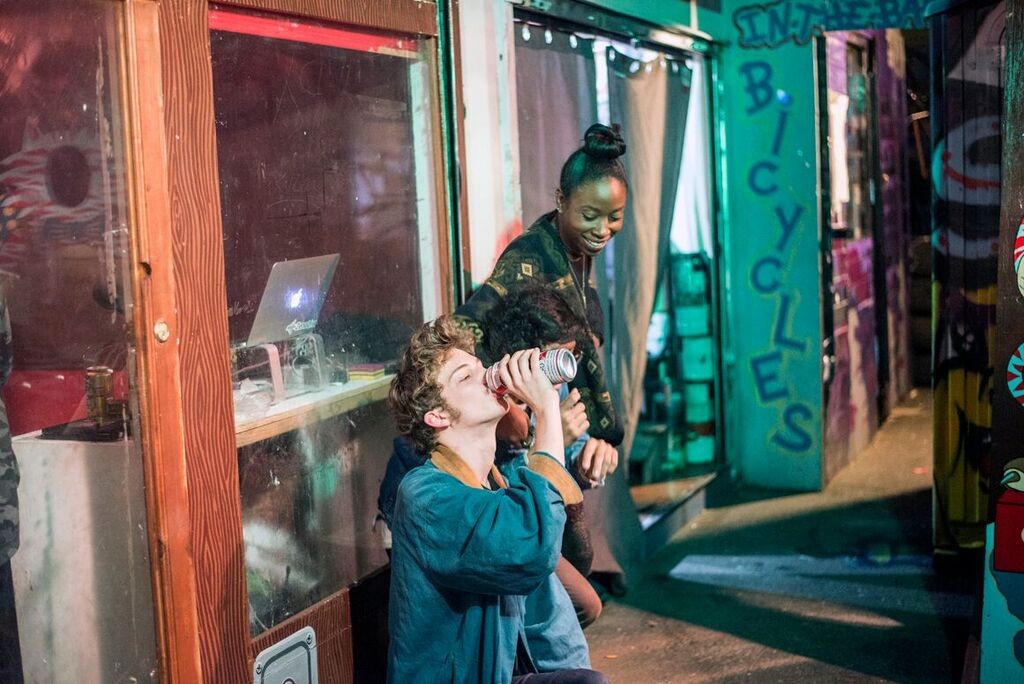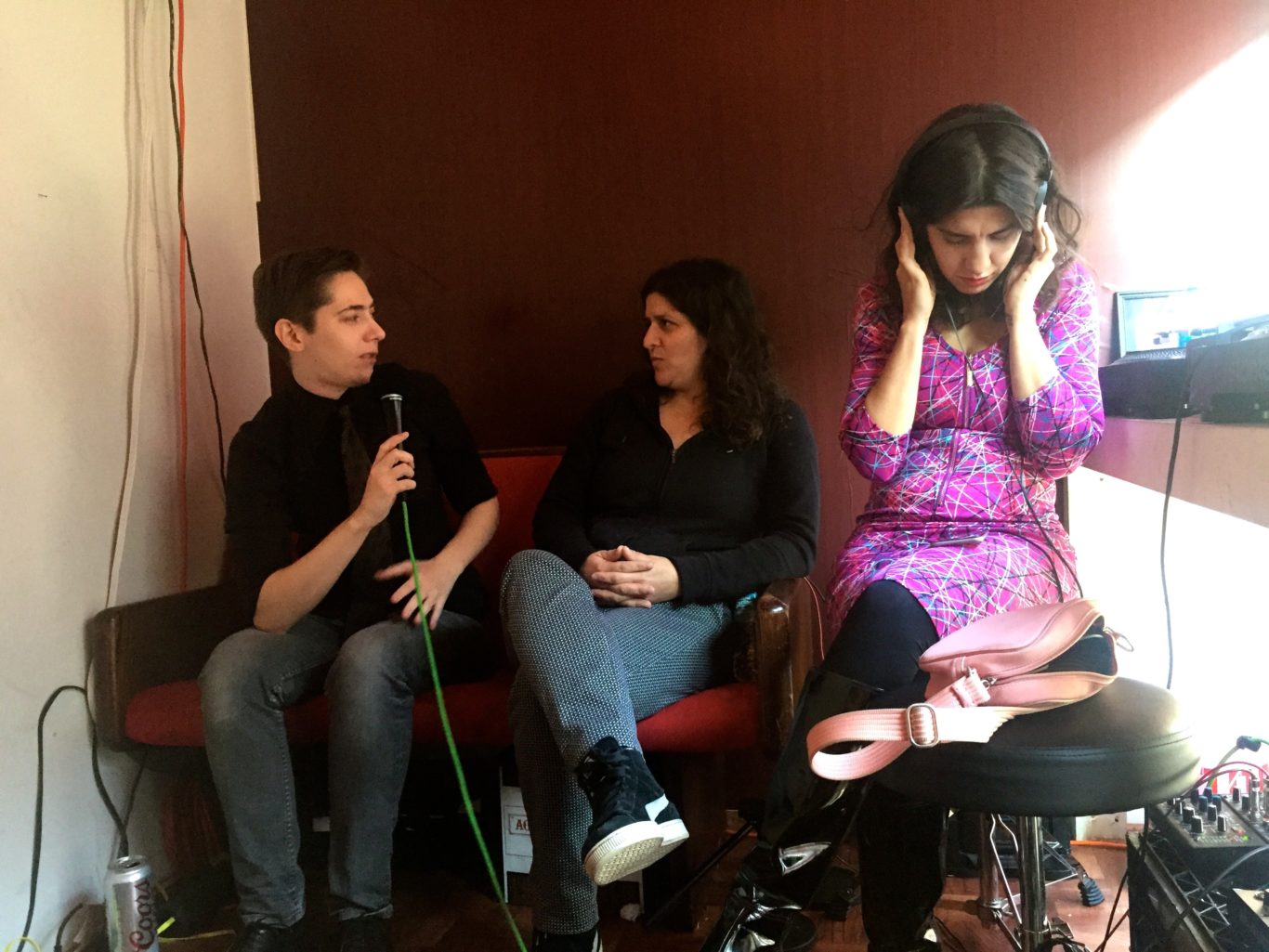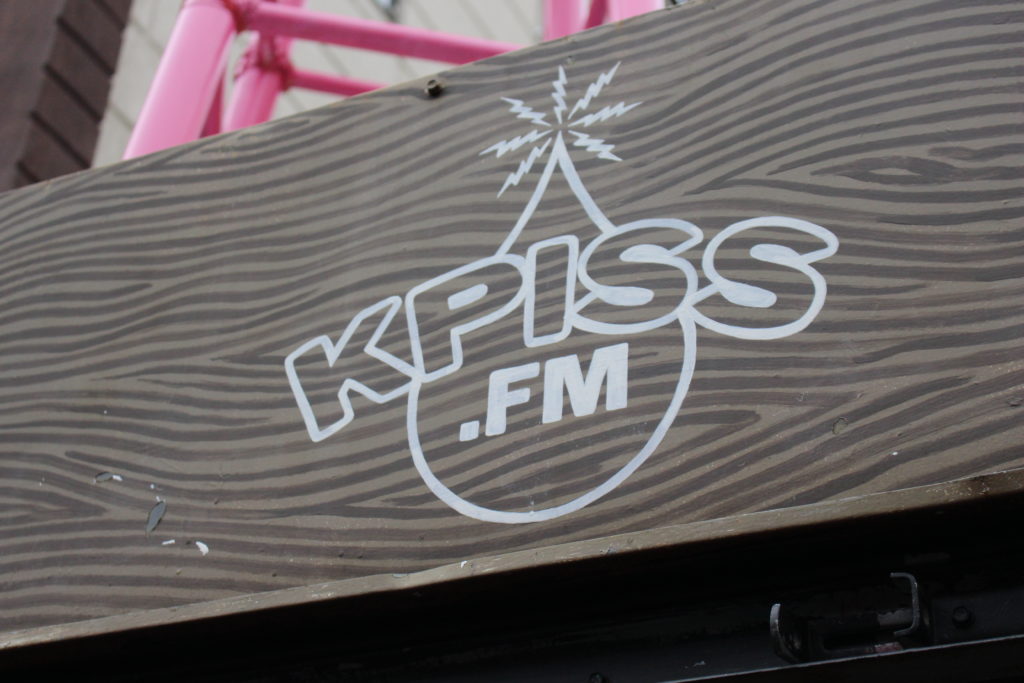You wouldn’t have any idea that it exists if you didn’t know where to look. Packed away haphazardly under the J/M/Z in the Bedford-Stuyvesant neighborhood of Brooklyn sits a small alleyway — locally referred to as “Punk Alley.” Teeming with life, its sides are lined with wholly independent shops and custom artwork. One peek down its long, narrow corridor and you’re greeted with vibrant colors, a half-assembled mannequin, trinkets for sale in several scattered baskets and music emanating from at least one (probably several) storefronts. The businesses are housed in shipping containers, and all here have been repurposed into shops with makeshift doors and windows. Though the stores are transient, right now there’s a used book store (where you might be hard-pressed to find anything over a few bucks), a used record shop (specializing in the sale and collection of rare surf rock), a cassette-based experimental noise record label and, of course, KPISS: the resident pirate radio station.
KPISS is as much a community effort as it is an independent one. It’s community-driven (most of the shows consist of local DJs, hosts and artists) and independent in that it’s fully self-sustaining (every official member of KPISS must pay a small membership fee). While traditionally, “pirate radio” might have referred to the wave of terrestrial FM radio stations that were broadcasting without license, the term has evolved into a catchall of sorts. Within the context of this article – we’re using the term as a phrase to describe any wholly independent radio station (whether internet or antenna) that serves a purpose and a community. Even though it’s not hosted on a traditional FM radio station, it lives online at kpiss.fm, and across most internet radio streaming services.

Photo: Dalvin Aboagye
Despite the emergence technologies and services that one might assume would detract from traditional radio’s audience, it remains popular within the U.S. What sets internet radio apart is its non-reliance on federal regulations and a low overhead. KPISS operates within these parameters, and Sheri Barclay is the ringmaster. KPISS features a variety of content, from music to talk shows to whatever they want. Local DJ Jonny Katz described his passion for it best: “I also respected the feel of KPISS… something you could join while doing it by yourself. If you have access to the space then you really have an unlimited amount of ideas to try out.”
I’m walking down Broadway on an early morning in May. The sun hasn’t yet made the day unbearable. I’m on my way to meet Sheri; we agreed to meet at the studio. I’m a block or two away when the streets start coming to life. It’s one of the first nice days of the year.
The studio’s exterior is mostly plexiglass. The panel above the studio window is painted to resemble a radio’s dial, complete with knobs for AM, FM, volume and balance. Inside, leg room is sparse. The walls are lined with various pictures and other assorted objects such as a Lisa Frank-esque picture of a unicorn, an old Pepsi advertisement hanging above the DJ, an unopened fun-pack of colorful toothbrushes and, of course, a framed picture of our patron saint Tom Jones.
“Everything you see is custom built,” Sheri says with a sense of pride. “There was no floor, just dirt. We built all of this pieces at a time.”
“So where do you want to do this?” she asks me as she finished troubleshooting a recording session. She steps through her makeshift door and into the alley. She has long brown hair and is wearing a brown jacket over a shirt from one of her favorite local strip clubs.
I’m not particular. “Anywhere, honestly,” I say.
“Okay, well, grab your stuff. I have an actual office down the street. It’s in a pizzeria.”
She had a quid pro quo with Milly’s Pizzeria down the block.
Sheri is an interesting character. At 35, she currently lives in Brooklyn doing freelance audio work for podcasts, radio stations and media companies and brands. As a kid in Edmonton, Alberta, Sheri was exposed to the world of alternative artistic subculture. “I grew up in Canada, and I was introduced to the DIY scene at about 15 years old,” she says. “DIY in Canada is really serious, because Canada doesn’t have a culture, you really have to make your own everything.”
As we sit there and continue eating, I ask her about a moment there that really stuck with her.

Photo: KPISS
“Do you know Nardwuar?” she asks. “He created this whole thing from scratch and he started out on college radio. I saw him at an all-ages show at a community center when I was 15. It was organized, run and attended by 15 to 18-year-olds, and all promoted with flyers.”
Canadian national treasure Nardwuar is perhaps best known for his off-the-wall and goofy interviews with artists. It’s entertaining, sometimes absurd, but always unique. It’s that very same blend of goofiness and eccentricity that Sheri infused into KPISS, making it so absurdly enjoyable in the first place.
From there, Sheri eventually developed an interest in audio mechanics. She volunteered at various radio stations around the area, learning the basics and then some.
In 2003, Sheri moved to Brooklyn, a crown jewel of arts and culture. “I caught the tail end of that 90’s Williamsburg bohemianism,” she quips. Once here, she began making her way through a variety of freelance gigs, but her interests lay in getting in with East Village radio, or even better, New Jersey’s own WFMU.
Turns out that was easier said than done.
Sheri began really thinking about the systematic structure — and largely male-inhabited — world of pro-radio. The limitations, technique and approach seemed outdated and almost pretentious. She wanted to create a space for the people who thought outside the box—a place where creativity could thrive. “I wanted a place where you still had to have an idea, y’know?” she tells me. “I’m not a snob about that stuff, and I hated that feeling of going through a hazing process and having to prove to someone how cool I was.”
KPISS’ very name is, in many respects, the embodiment of what it is. “When we started, so many people thought I wouldn’t get away with calling it KPISS,” she says. “But I had to do something to shake it up and get people’s attention. I’m from Canada, so the phrase ‘take the piss out out of something’ really resonated with me. You’re kind of making fun of something and inverting it at the same time.”
And that’s one of the keys to KPISS’ appeal: it’s self-aware. This is a station that know it’s weird, bizarre, unorthodox, and both embraces and subverts it at the same time. Existing in self-aware, let-me-be-serious-for-a-second New York City culture, this unpretentiousness approach was and still is refreshing. “Canadians can get away with that more than anything,” Barclay says. “We have that ingrained capability to be transparent and goofy in a way that maybe Americans can’t. That helps me a lot with what I’m doing.”
KPISS exists during a time where terrestrial radio isn’t the only major player in the media game. We’re living in a new media landscape where we have seemingly endless mediums and opportunities to discover new music or to listen to our favorite shows. The rise in popularity of streaming services and the emergence of the entire podcasting ecosystem provide consumers with a whole new world of choice. Still, traditional radio remains strong. According to Nielsen (a company that monitors entertainment data within the United States) 90 percent of American consumers listen to terrestrial radio on a weekly basis (this number was 96 percent in 2001). Still, radio is now forced for compete for the same audience within an increasingly segmented consumer population. Its voice is one of many in a crowded field.

Photo: KPISS
For a long time, though, radio’s influence was pretty unwavering. One DJ’s opinion on a record or artist could send a record soaring to No. 1, influence the flavor music of the day and even make or break a career. But this makes sense. The music industry model was about as linear as the series arc for “Lost.” The artist recorded the music, the music was pressed onto wax and those records were sent to either record shops around the country or to radio. Touring existed, but whether or not your music caught the ear of an influential DJ could determine the cities you visited, the crowds you drew — or even if you toured at all. According to the same Nielsen report, 49 percent of Americans still use radio to discover new music, but the market is fractured. This leaves 51 percent of the audience utilizing other means to discover new music (including independent radio).
In a post-internet world, independent radio has been pushed underground and, in some cases, online. Internet radio has been around for a hot minute, and its low overhead means that anyone — literally anyone — can start their own internet radio station. Free from restrictive federal regulations, it’s a free-for-all. All you need is a microphone, a computer and access to a decent internet connection. For Sheri, keeping independent radio alive meant operating out of a storage unit no bigger than a midsize sedan.
“With corporate radio, I think they’ll vanish as we know them in five years, or at least be sold off to Latino communities,” she says. “They listen to the radio more than anyone and because of that, there’s more ad revenue.”
“Here’s the thing… we’re all competing for the same niche audience. Sometimes it gets a little confusing,” Sheri says as she finishes her slice of pizza. She’s referring here to the ecosystem of local internet radio stations such as Radio Free Brooklyn and The Lot Radio. In some cases, Sheri has seen some of her DJs bring their talent to other local internet stations. “Again, It’s competition… but we’re also in the same boat. We can help each other even though there’s that fierce competition for the same niche audience. It’s KPISS, but there’s no literal pissing contest.”

Photo: Dalvin Aboagye
Sheri insists on keeping KPISS as connected and true to the community as possible. “One show is a whole bunch of Dominican guys talking shit with each other, and another is feminist comedians, another show is about surfing, another show is about two black chicks who are goth and their experience being goth,” says Sheri, gleefully. This commitment to quality diversity is what sets KPISS apart from the slew of other internet stations. It can be a tricky balance to come into a neighborhood — particularly anywhere in NYC — as an outsider and not disrupt things. These days, with the burden of gentrification on the shoulders of native locals, business owners need to put great effort into finding ways to both benefit themselves and the community they’ve settled upon. Deeply embedding that community within the fabric of KPISS was one of Sheri’s primary goals.
Beyond this, the natural, genuine feel that these shows, and the station at large, have great empathy and humanity to them. But even Barclay admits that it can be hard to maintain this quality. “It’s really not enough to just come on with your cool Spotify playlist of X-ray Spex and Kendrick Lamar and just talk about your job. I’m not trying to say that people don’t do that on college radio, because it happens — and it sucks. That’s the one thing that a lot of people don’t want to admit… sometimes freeform radio sucks. And it’s kind of cheap therapy for whoever does it.”
As the interview wraps up, we walk outside back towards the alley. It’s later in the day now, and the sun has become hidden by a wall of clouds. Truthfully, on this street, the light is always obstructed by the overhead tracks. It just seems darker now. We say our goodbyes.
As I walk away with the photographers, I replay the experience in my head. As a whole, this has proven to be a deep dive into a small, yet potent pocket of the East Coast DIY scene, one that’s seen the fabric of its community tried over the past several years as venues like Death by Audio, Shea Stadium and Aviv shutter. Even Palisades — a former staple in the DIY community — shuttered in the summer of 2016 during an after-hours party. Located directly across from Punk Alley, it recently reopened as an upscale Italian restaurant. Yet KPISS holds on, and doesn’t inhabit that faux bo-ho world that we see in shitty Sundance films or Off-Broadway plays. Rather, it’s something far more powerful. It’s a world where ideas matter over capital. It’s a world in which diversity is treated as a strength, not a chore.
Corporate radio will most likely always have a place in society, but at the same time, unless it updates its systematic operations, independent media will take its place as king. Is that a good thing? A bad thing? Perhaps neither, and is it just a part of the media circle of life? Who’s to say?
KPISS isn’t re-inventing the wheel, nor does it claim to be. However, there is this great originality and an admirable spirit that shines through its speakers as you listen. KPISS is a 2018 version of a pirate radio station, and as a result, it can afford freedoms that traditional FM stations cannot. There’s a freedom to create new things, to experiment with different styles, and, above all else, just be plain fucking weird.
After all, this is KPISS, but there isn’t a literal pissing contest.




Comments are closed.